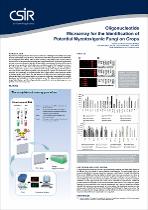 ResearchSpace
ResearchSpace
Oligonucleotide microarray for the identification of potential mycotoxigenic fungi on crops
JavaScript is disabled for your browser. Some features of this site may not work without it.
- ResearchSpace
- →
- Research Publications/Outputs
- →
- Conference Publications
- →
- View Item
| dc.contributor.author |
Lezar, S

|
|
| dc.contributor.author |
Barros, E

|
|
| dc.date.accessioned | 2010-02-01T08:01:12Z | |
| dc.date.available | 2010-02-01T08:01:12Z | |
| dc.date.issued | 2009-09 | |
| dc.identifier.citation | Lezar, S and Barros, E. 2009. Oligonucleotide microarray for the identification of potential mycotoxigenic fungi on crops. Bio2Biz SA. Durban, South Africa, 20-23 September 2009, pp 1 | en |
| dc.identifier.uri | http://hdl.handle.net/10204/3923 | |
| dc.description | Bio2Biz SA. Durban, South Africa, 20-23 September 2009 | en |
| dc.description.abstract | Mycotoxins are fungal toxins which pose a continuous challenge to the safety and quality of food commodities in South Africa. These toxins can cause unthriftiness, loss of appetite, feed refusal, liver cirrhosis, vomiting, poor weight gain, various cancers and mortality on humans and animals that eat contaminated foods. In this study a diagnostic microarray was developed to identify potentially mycotoxigenic fungi as well as genes leading to toxin production in both laboratory and food samples derived from maize and other crops that can be infected by these fungi. For fungal identification, oligonucleotide probes were designed by exploiting the sequence variations of the elongation factor (EF) coding regions and the internal transcribed spacer (ITS) regions separating the genes coding for 18S rRNA, 5.8S rRNA and 28S rRNA. For the detection of fungi able to produce mycotoxins, oligonucleotides directed towards genes leading to toxin production in different fungal strains were identified in data available in the public domain. The oligonucleotides selected for fungal identification and the oligonucleotides specific for toxin producing genes were spotted onto microarray slides.The microarray developed showed that fungal pathogens and toxin producing genes can successfully be identified using this diagnostic array. | en |
| dc.language.iso | en | en |
| dc.subject | Mycotoxigenic fungi | en |
| dc.subject | Microarray | en |
| dc.subject | Oligonucleotide | en |
| dc.subject | Locked nucleic acid | en |
| dc.subject | Bio2Biz | en |
| dc.title | Oligonucleotide microarray for the identification of potential mycotoxigenic fungi on crops | en |
| dc.type | Conference Presentation | en |
| dc.identifier.apacitation | Lezar, S., & Barros, E. (2009). Oligonucleotide microarray for the identification of potential mycotoxigenic fungi on crops. http://hdl.handle.net/10204/3923 | en_ZA |
| dc.identifier.chicagocitation | Lezar, S, and E Barros. "Oligonucleotide microarray for the identification of potential mycotoxigenic fungi on crops." (2009): http://hdl.handle.net/10204/3923 | en_ZA |
| dc.identifier.vancouvercitation | Lezar S, Barros E, Oligonucleotide microarray for the identification of potential mycotoxigenic fungi on crops; 2009. http://hdl.handle.net/10204/3923 . | en_ZA |
| dc.identifier.ris | TY - Conference Presentation AU - Lezar, S AU - Barros, E AB - Mycotoxins are fungal toxins which pose a continuous challenge to the safety and quality of food commodities in South Africa. These toxins can cause unthriftiness, loss of appetite, feed refusal, liver cirrhosis, vomiting, poor weight gain, various cancers and mortality on humans and animals that eat contaminated foods. In this study a diagnostic microarray was developed to identify potentially mycotoxigenic fungi as well as genes leading to toxin production in both laboratory and food samples derived from maize and other crops that can be infected by these fungi. For fungal identification, oligonucleotide probes were designed by exploiting the sequence variations of the elongation factor (EF) coding regions and the internal transcribed spacer (ITS) regions separating the genes coding for 18S rRNA, 5.8S rRNA and 28S rRNA. For the detection of fungi able to produce mycotoxins, oligonucleotides directed towards genes leading to toxin production in different fungal strains were identified in data available in the public domain. The oligonucleotides selected for fungal identification and the oligonucleotides specific for toxin producing genes were spotted onto microarray slides.The microarray developed showed that fungal pathogens and toxin producing genes can successfully be identified using this diagnostic array. DA - 2009-09 DB - ResearchSpace DP - CSIR KW - Mycotoxigenic fungi KW - Microarray KW - Oligonucleotide KW - Locked nucleic acid KW - Bio2Biz LK - https://researchspace.csir.co.za PY - 2009 T1 - Oligonucleotide microarray for the identification of potential mycotoxigenic fungi on crops TI - Oligonucleotide microarray for the identification of potential mycotoxigenic fungi on crops UR - http://hdl.handle.net/10204/3923 ER - | en_ZA |





